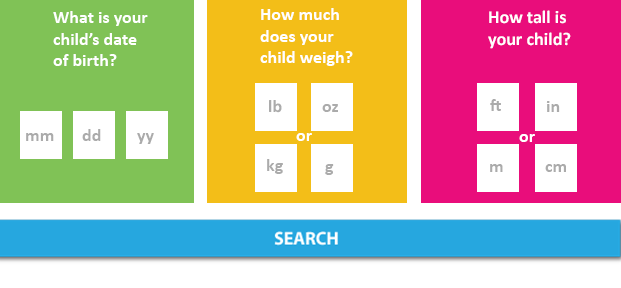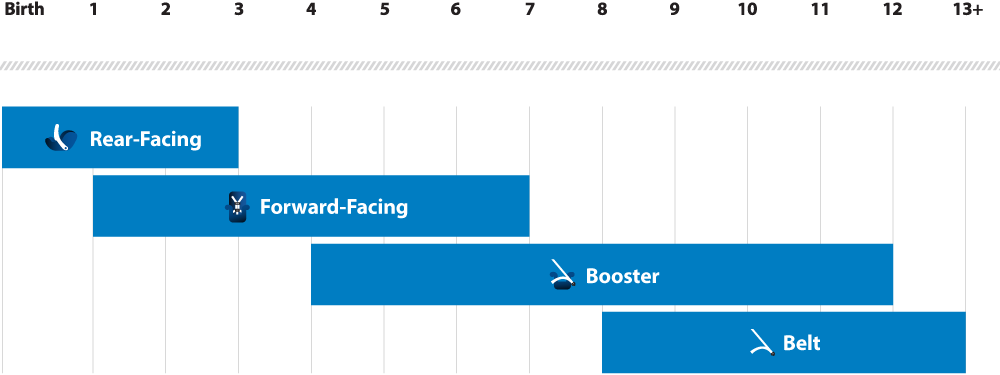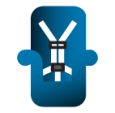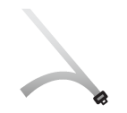How Much Should a Child Weigh to Forward Face
Car seats and boosters provide protection for infants and children in a crash, yet car crashes are a leading cause of death for children ages 1 to 13. That's why it's so important to choose and use the right car seat correctly every time your child is in the car. Follow these important steps to choose the right seat, install it correctly and keep your child safe.
Indiana's child passenger safety law requires all children less than eight years of age to be properly restrained in a federally approved child restraint system, which can include a belt positioning booster seat. Children at least 8 years old until their 16th birthday must be properly restrained in a child restraint or seat belt in all seating positions in all vehicles. For additional information on Indiana's child restraint law, click here.
ICJI conducts child passenger safety education and outreach activities through the Automotive Safety Program (childseat.in.gov). This includes more than 100 permanent locations where families and caregivers can go to have their child restraint installation inspected by a certified child passenger safety technician.

The Process
Find the right car seat
- Learn about the four car seat types
- Follow NHTSA's car seat recommendations based on your child's age and size
- Find and compare car seats and ease-of-use-ratings using NHTSA's Car Seat Finder
Install your car seat correctly
- Understand the parts and tips used for installation
- Follow our detailed car seat installation instructions and videos
- Get your car seat inspected at a station nearest you
Keep your child safe in a car seat
- Register your car seat and sign up for recall notices to receive safety updates
Car Seat Recommendations
There are many car seat choices on the market. Use the information below to help you choose the type of car seat that best meets your child's needs or print out NHTSA's car seat recommendations for children.
- Select a car seat based on your child's age and size, then choose a seat that fits in your vehicle, and use it every time.
- Always refer to your specific car seat manufacturer's instructions (check height and weight limits) and read the vehicle owner's manual on how to install the car seat using the seat belt or lower anchors and a tether, if available.
- To maximize safety, keep your child in the car seat for as long as possible, as long as the child fits within the manufacturer's height and weight requirements.
- Keep your child in the back seat at least through age 12.

Rear-Facing Car Seat

Birth-12 Months
Your child under age 1 should always ride in a rear-facing car seat. There are different types of rear-facing car seats:
- Infant-only seats can only be used rear-facing.
- Convertible and all-in-one car seats typically have higher height and weight limits for the rear-facing position, allowing you to keep your child rear-facing for a longer period of time.
1 – 3 Years
Keep your child rear-facing as long as possible. It's the best way to keep him or her safe. Your child should remain in a rear-facing car seat until he or she reaches the top height or weight limit allowed by your car seat's manufacturer. Once your child outgrows the rear-facing car seat, your child is ready to travel in a forward-facing car seat with a harness and tether.
Forward-Facing Car Seat

1 – 3 Years
Keep your child rear-facing as long as possible. It's the best way to keep him or her safe. Your child should remain in a rear-facing car seat until he or she reaches the top height or weight limit allowed by your car seat's manufacturer. Once your child outgrows the rear-facing car seat, your child is ready to travel in a forward-facing car seat with a harness and tether.
4 – 7 Years
Keep your child in a forward-facing car seat with a harness and tether until he or she reaches the top height or weight limit allowed by your car seat's manufacturer. Once your child outgrows the forward-facing car seat with a harness, it's time to travel in a booster seat, but still in the back seat.
Booster Seat

4 – 7 Years
Keep your child in a forward-facing car seat with a harness and tether until he or she reaches the top height or weight limit allowed by your car seat's manufacturer. Once your child outgrows the forward-facing car seat with a harness, it's time to travel in a booster seat, but still in the back seat.
8 – 12 Years
Keep your child in a booster seat until he or she is big enough to fit in a seat belt properly. For a seat belt to fit properly the lap belt must lie snugly across the upper thighs, not the stomach. The shoulder belt should lie snugly across the shoulder and chest and not cross the neck or face. Remember: your child should still ride in the back seat because it's safer there.
Seat Belt

8 – 12 Years
Keep your child in a booster seat until he or she is big enough to fit in a seat belt properly. For a seat belt to fit properly the lap belt must lie snugly across the upper thighs, not the stomach. The shoulder belt should lie snugly across the shoulder and chest and not cross the neck or face. Remember: your child should still ride in the back seat because it's safer there.
- Additional Resources
- How to Install Rear-Facing Car Seats
- How to Install Forward-Facing Car Seats
- How to Install Booster Seats
How Much Should a Child Weigh to Forward Face
Source: https://www.in.gov/cji/traffic-safety/occupant-protection/children/